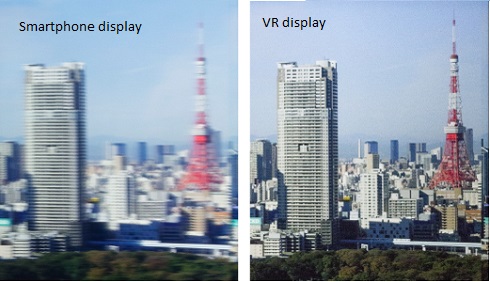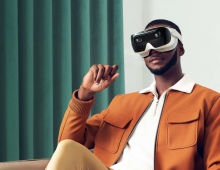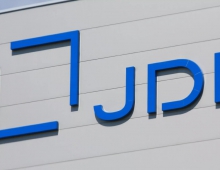
JDI Develops A 3.42-inch LCD For Virtual Reality Applications
Japan Display (JDI) has developed a 3.42-inch low temperature polysilicon (LTPS) TFT LCD specifically designed for virtual reality (VR) head mount displays (HMD) and started sample delivery.
The new LTPS TFT LCD provides the required display performance and characteristics for VR applications, including ultra-high resolution, high-speed response time, high refresh rate, and blinking backlight. These features enable the new VR-HMD LCD to show life-like images.
The recent technology evolution in sensors, displays, signal processing and signal transmission has greatly improved the VR user-experience, which in turn has supported the growth of the VR market. According to JDI, currently-available displays do not satisfy the required level of "VR quality" in terms of resolution, response time and motion quality because they are not designed for VR applications but instead for smartphones. JDI has succeeded in developing a display specifically-designed for VR device.
Since a VR-HMD has lenses between the user's eyes and the display, which magnifies the display image, the user's eyes can see the structure of pixels when smartphone-type displays are used. This spoils the feeling of reality and sense of immersion. JDI's ultra-high resolution display has a pixel density of 651ppi, with which the user can hardly see the pixel structure. JDI plans to develop and start sample shipments of an even higher resolution 800ppi display next.

Since there are many cases in which objects move quickly on a VR display, motion blur can be a major problem. In order to suppress motion blur, JDI has employed a high refresh rate of 90Hz, a high-speed IPS LCD with response time 3 msec (black-to-white), and blinking backlight technology (with a 10% duty rate, typical).

The "system latency" of a VR device is defined as the time latency beginning from the moment the motion sensor recognizes the start of the user's movement to the moment the image is displayed on the VR-HMD. If the system latency is too long, the user's brain becomes stressed, and the user cannot continue using the VR-HMD. JDI's VR display has a high refresh rate and a high-speed IPS LCD, which contributes to shorten the latency of the display which is a significant part of the overall system latency.
Display Specifications
Display size (diagonal): 3.42 inches
Resolution: 1440 x RGB x 1700
Pixels per inch: 651ppi
Refresh rate: 90Hz
Response time:
3 msec (black-to-white) 6 msec (worst case)
Brightness: 150cd/m2 (with 10% duty rate blinking backlight)
Contrast ratio: 700:1 (Typ.)
The recent technology evolution in sensors, displays, signal processing and signal transmission has greatly improved the VR user-experience, which in turn has supported the growth of the VR market. According to JDI, currently-available displays do not satisfy the required level of "VR quality" in terms of resolution, response time and motion quality because they are not designed for VR applications but instead for smartphones. JDI has succeeded in developing a display specifically-designed for VR device.
Since a VR-HMD has lenses between the user's eyes and the display, which magnifies the display image, the user's eyes can see the structure of pixels when smartphone-type displays are used. This spoils the feeling of reality and sense of immersion. JDI's ultra-high resolution display has a pixel density of 651ppi, with which the user can hardly see the pixel structure. JDI plans to develop and start sample shipments of an even higher resolution 800ppi display next.

Since there are many cases in which objects move quickly on a VR display, motion blur can be a major problem. In order to suppress motion blur, JDI has employed a high refresh rate of 90Hz, a high-speed IPS LCD with response time 3 msec (black-to-white), and blinking backlight technology (with a 10% duty rate, typical).

The "system latency" of a VR device is defined as the time latency beginning from the moment the motion sensor recognizes the start of the user's movement to the moment the image is displayed on the VR-HMD. If the system latency is too long, the user's brain becomes stressed, and the user cannot continue using the VR-HMD. JDI's VR display has a high refresh rate and a high-speed IPS LCD, which contributes to shorten the latency of the display which is a significant part of the overall system latency.
Display Specifications
Display size (diagonal): 3.42 inches
Resolution: 1440 x RGB x 1700
Pixels per inch: 651ppi
Refresh rate: 90Hz
Response time:
3 msec (black-to-white) 6 msec (worst case)
Brightness: 150cd/m2 (with 10% duty rate blinking backlight)
Contrast ratio: 700:1 (Typ.)





















